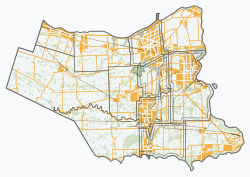Top Qs
Timeline
Chat
Perspective
Regional Municipality of Niagara
Regional municipality in Ontario, Canada From Wikipedia, the free encyclopedia
Remove ads
The Regional Municipality of Niagara, also colloquially known as the Niagara Region or Region of Niagara, is a regional municipality in southern Ontario, Canada, which occupies most of the Niagara Peninsula. As of 2024, the region had an estimated population of 539,180.[4] St. Catharines is the region's largest city, while the regional seat is located in Thorold.
The Niagara Region is bounded to the north by Lake Ontario and to the south by Lake Erie. The region is bordered in the west by Haldimand County and the City of Hamilton, with its eastern boundary at the Niagara River, which is also the international border with the US state of New York. The Niagara Region is the southernmost part of the Golden Horseshoe, the most populated region of Ontario.
Unique natural landscapes make the Niagara Region an important centre for agriculture and tourism in Canada. The most important agricultural enterprise in Niagara is viticulture, or winemaking. The Niagara Wine Route, which connects visitors to dozens of wineries, is a growing tourism draw while the internationally renowned Niagara Falls is one of Canada's major tourist attractions. Along with Shaw Festival, held annually in Niagara-on-the-Lake, and the Welland Canal, the Regional Municipality of Niagara receives up to 12 million visitors each year. The Niagara Region has a rich history of First Nations such as the Neutral, the Haudenosaunee, and the Anishinaabe, including the Mississaugas of the Credit First Nation.[5]
Remove ads
Administrative divisions

Remove ads
Demographics
Summarize
Perspective
As a census division in the 2021 Census of Population conducted by Statistics Canada, the Regional Municipality of Niagara had a population of 477,941 living in 195,914 of its 207,926 total private dwellings, a change of 6.7% from its 2016 population of 447,888. With a land area of 1,852.82 km2 (715.38 sq mi), it had a population density of 258.0/km2 (668.1/sq mi) in 2021.[2]
Canada census – Regional Municipality of Niagara community profile
Religion
Religious profile (2021):[2]
Ethnicity
Human trafficking
The area has a higher concentration of human trafficking compared to other regions in Canada, with 3% of recorded incidents taking place within it. The Niagara Region's proximity to the border and large amounts of hotels are considered to be contributing factors to this issue.[13]
Remove ads
Transportation
Summarize
Perspective
Airports
Niagara Region contains three airports used primarily for general aviation:
- St. Catharines/Niagara District Airport (Niagara-on-the-Lake)
- Welland/Niagara Central Airport (Welland)
- Niagara Falls/Niagara South Airport (Niagara Falls)
Aside from scheduled commuter flights between Niagara District Airport and Toronto City with FlyGTA, for commercial flights Niagara residents use Toronto Pearson International Airport, Billy Bishop Toronto City Airport, or John C. Munro Hamilton International Airport in the Greater Toronto and Hamilton Area; as well as crossing the border to use Buffalo Niagara International Airport or Niagara Falls International Airport in Upstate New York.
Public Transport
Public transit within Niagara Region is provided by Niagara Region Transit, including scheduled local bus service within Niagara Falls, St. Catharines, Thorold and Welland, on-demand transit service in other portions of the Region, and regional bus service between communities in the region.
WEGO is an additional local bus network within Niagara Falls, targeted at visitors rather than residents. The WEGO Green Line is operated by the Niagara Parks Commission and requires separate WEGO tickets, while the remainder of WEGO routes are operated by Niagara Region Transit and accept both Niagara Region Transit and WEGO tickets.
GO Transit provides regional train and bus services from Niagara Falls and St. Catharines to the Greater Toronto and Hamilton Area.
VIA Rail serves Grimsby, St. Catharines and Niagara Falls stations as part of the Maple Leaf intercity train between Toronto and New York City, jointly operated with Amtrak.
Many private bus operators operate intercity services to Niagara Region on routes connecting to cities such as Toronto, Buffalo and New York. As of 2023, private bus operators in Niagara Region include Flixbus, Megabus, Equinox, Greyhound, and Trailways.
Highways
400-series expressways:
Other highways:
Remove ads
Education
- Brock University (St. Catharines)
- University of Niagara Falls (Niagara Falls)
- Conseil Scolaire Viamonde - French Public
- District School Board of Niagara - Public
- Niagara Catholic District School Board - Separate
- Niagara College (Niagara-on-the-Lake, Welland)
- Niagara Parks School of Horticulture (Niagara Falls, Ontario)
Remove ads
Notable people
- Cal Clutterbuck, former NHL player
- Paul Bissonnette, former NHL player
- James Cameron, film director
- Linda Evangelista, fashion supermodel
- Daniel Girardi, former NHL player
- Dallas Green, musician and producer known as "City and Colour"
- Tim Hicks, musician
- Nathan Horton, former NHL player
- Stephan Moccio, Grammy and Academy award-winning musician and composer
- Jordan Nolan, former NHL player
- Daniel Paille, former NHL player
- Neil Peart (1952–2020), drummer for the band Rush
- Laura Secord, heroine of War of 1812
- Joel Thomas Zimmerman, musician known as "Deadmau5"
- Imane Anys, Twitch streamer who goes by the name "Pokimane"
Remove ads
See also
Notes
Remove ads
References
External links
Wikiwand - on
Seamless Wikipedia browsing. On steroids.
Remove ads







